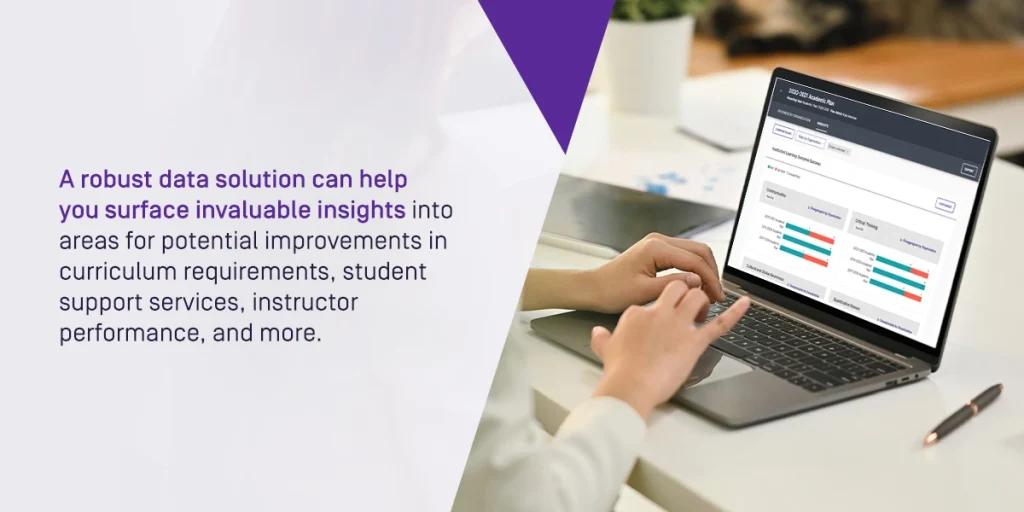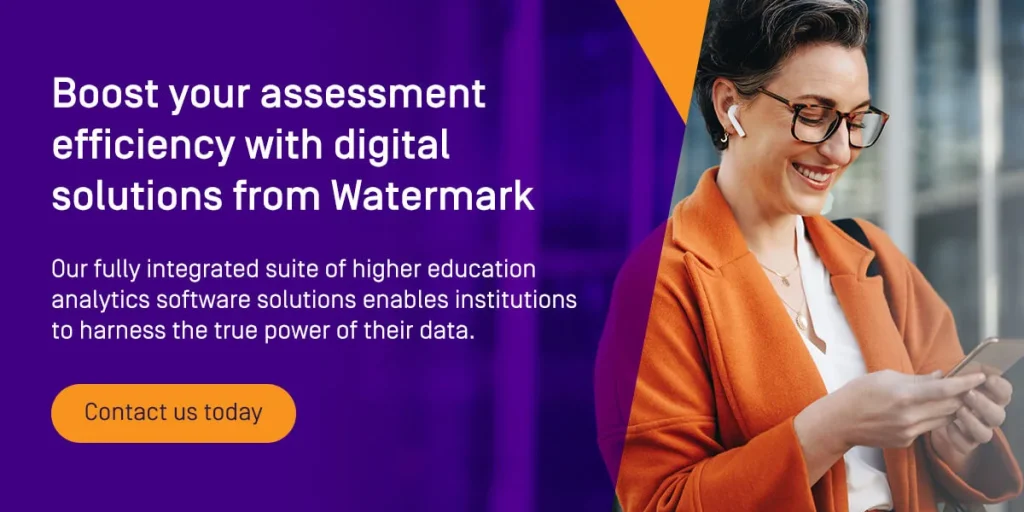




Assessment is critical for ensuring your institution delivers the high-quality education your students expect. But inefficient assessment processes can hold you back from getting the most value out of your findings.
When you know how to simplify and manage the assessment process better, you can fully commit to making real improvements at your institution.
Process management is a business term referring to the systematic approach an organization takes to ensure its business processes are as efficient and effective as possible.
Unlike project management, which focuses on specific initiatives, process management has a much broader scope. Typically, it involves all the routine processes an organization carries out in its everyday operations — in higher ed, these processes include but are not limited to assessment, enrollment and registration, and awarding financial aid packages.
Incorporating process management in higher ed allows administrators to take a more holistic approach to assessment and continuous improvement by eliminating major inefficiencies in existing systems. But it’s most effective when you have a clear idea of the steps you need to take to complete these tasks.
Following these best practices can help your institution more effectively manage your assessment and accreditation preparation processes.
At many institutions, increasing engagement from leadership and key stakeholders has transformed assessment from a routine practice into a foundational aspect of the institution’s culture. This change enables you to support continuous improvement in every institutional process, which is critical for maintaining your competitive edge within the market.
Creating a culture of assessment also involves expanding your assessment processes to non-academic as well as academic outcomes. Student support services, campus activities, and other important groups within your institution play a major role in a student’s experience, so being able to assess them efficiently is just as important for improving your institution as it is to assess your course offerings and faculty performance.
With academia’s rapidly accelerating pace of change, institutions need to focus on improving assessment processes beyond the present. It’s much smarter to create a process that can adapt to the times than it is to rely on one that only solves the problems your institution faces right now.

That’s why investing in the right tech tools is so important. A robust data solution can help you surface invaluable insights into areas for potential improvements in curriculum requirements, student support services, instructor performance, and more.
When you adopt an advanced, adaptable data analytics solution for higher ed, you can unlock the true power of your assessment data. Plus, your software vendor will provide routine product updates and maintenance, so your institution can focus on implementing the changes you need to make.
Modern technology is essential for simplifying process management and preparing your institution for the coming technological shifts. Here are the top five ways better process management contributes to improving the higher ed assessment process.
Data analysis is key to the assessment process, as it reveals actionable insights that can inform important business and academic decisions. While most higher education institutions collect vast amounts of data, few have the tools or infrastructure required to efficiently use it all.
Advanced software solutions with built-in automation capabilities save valuable time in collecting and analyzing assessment data, so your faculty can focus on value-added tasks.
Self-study reporting is one of the most important processes in accreditation prep because it allows department faculty to proactively identify and make the required changes to improve their program offerings.
For many institutions, though, the self-study process is stressful and inefficient. Busy faculty members have little time to spend on administrative tasks like assessment planning and reporting — and when all your assessment data is spread across various digital and paper systems, they need to spend additional time searching for it.
Implementing a unified solution that offers simplified report templates helps reduce the amount of time faculty members need to spend on locating data and organizing the results of their analyses.
When you have to manually transfer assessment data between disparate systems — or copy data from paper documents to digital databases — there’s naturally a risk of human error.
Planning and self-study software that integrates with the rest of your tech stack creates a seamless flow of data across your institution, so you can reuse the data you already have instead of needing to spend hours transferring it between systems.
Plus, interactive dashboards and intuitive functions guide users through the process, reducing the chances of a new faculty member completing the process incorrectly.
One of the biggest trends in higher ed assessment is a shift away from end-of-term summative assessments in favor of more frequent formative assessments. Conducting multiple formative assessments throughout the term allows instructors to be more dynamic in adapting their teaching methods.
Digital assessment tools accelerate the assessment process, so instructors can be even more flexible in changing their approach to teaching as needed throughout the semester. Additionally, intuitive course evaluation software makes student satisfaction surveys easier to administrate and analyze — this can help boost response rates and give you more of the data you need to make a decision.
Now that many institutions are moving away from traditional paper-based assessment processes, it’s becoming more important to include stakeholders in the process. Assessment has the biggest impact on faculty members and students, and involving them in the process can boost engagement and contribute to better retention outcomes.
If you’re looking for a software tool that will help your institution streamline assessment and process management, Watermark Planning & Self-Study can help. With its capability to support collaborative self-studies and a library of pre-built templates to choose from, Planning & Self-Study helps your assessment teams unlock the power of your assessment data.
Our fully integrated suite of higher education analytics software solutions enables institutions to harness the true power of their data at every level of their organization. Whether you’re preparing for your next accreditation reevaluation or looking to improve student success rates, implementing our tools can help you achieve your desired outcomes.
Contact us today to get started with a live demo. We’ll show you how our comprehensive software suite can streamline your assessment processes in real-time so you can make the most informed decision.






























































































































































































































































































































































































